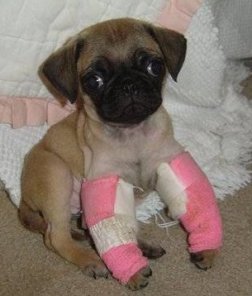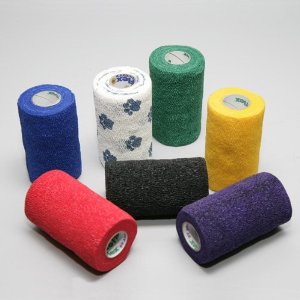Essential Bandage Care for Pets
 When your pet comes home from the veterinary hospital with a bandage on his leg, you may be thinking that the cute little guy (or gal) is using that bandage to milk all the sympathy he can get from you, but that bandage is serving a serious purpose and can cause harm if not properly cared for. Bandages are used for many reasons. Typically, they are used to protect an incision or wound from dirt or contamination, or keep your pet from licking or scratching, which can delay healing. They are also used to immobilize an injured body part or cover a layer of medication applied to a wound. If additional immobilization is necessary, a splint can be incorporated into the bandage. Bandages are rarely applied to solicit sympathy, but this is often an unanticipated side effect.
When your pet comes home from the veterinary hospital with a bandage on his leg, you may be thinking that the cute little guy (or gal) is using that bandage to milk all the sympathy he can get from you, but that bandage is serving a serious purpose and can cause harm if not properly cared for. Bandages are used for many reasons. Typically, they are used to protect an incision or wound from dirt or contamination, or keep your pet from licking or scratching, which can delay healing. They are also used to immobilize an injured body part or cover a layer of medication applied to a wound. If additional immobilization is necessary, a splint can be incorporated into the bandage. Bandages are rarely applied to solicit sympathy, but this is often an unanticipated side effect.
You may be surprised to see the bulky size of the bandage, but that is because small adhesive bandages do not work very well on animals. They don’t stick particularly well to animal hair and it is too easy for your pet to chew them off. Instead, you pet’s bandage will likely be made with several layers of material and will completely encircle the affected body part wherever possible.
The first layer of bandage material will be in contact with the wound. A non-adherent dressing will be used if the wound is clean and healthy. If the wound is contaminated, a sticky dressing will be applied instead to help remove infection and debris. The next layer will be padding to provide support, cushion the wound, and absorb fluid. The final layer will be stretchy material to hold everything in place. This is the layer that is often patterned with cute paw prints, or bright seasonal colors (think green & red for Christmas!).

Daily monitoring of the bandage is vital to detect early signs of trouble and avoid serious complications. Bandages must be kept clean and dry. If the bandage gets wet, there is no way for the deeper layers to dry out. The wet bandage material will sit up against the skin, weakening the skin as a barrier to infection and injury. If the ground is wet when you take your pet outside for his bathroom walks, cover the bandage with a plastic bag, if possible, and secure with a little tape. Do not forget to remove the wet plastic as soon as you return home. Despite our best attempts to secure bandages, they can sometimes slip down, much like a pair of ill-fitting socks bunching up around your ankles. If this happens, the bandage is no longer in the optimal position to do its job, and it can become too tight, constricting the blood circulation. Every day, the bandage should be checked to make sure that it is still in the same position as the day before. If it gets too tight, you’ll notice swelling at the top or bottom of the bandage, and the limb may feel cool to the touch. Although bandages provide many useful benefits, the one glaring problem is that we lose the ability to look at the wound or incision underneath it. If infection has occurred, you won’t be able to see it unless the bandage is removed. Instead, you must rely on your other senses. Infections stink. Literally… they smell. If you detect a bad odor, or wetness soaking through to the outer layer of the bandage, it’s time to have it checked. When a bandage is applied to a leg, the toes are often left visible through a small window at the bottom of the bandage. This is done so that you can monitor the toes to make sure they are not swollen, red, too hot, or too cold.
Lastly, one of the most common causes for bandage problems in pets is the pets themselves. Unfortunately, some animals just love to chew, and their bandages are not spared. Foul-tasting sprays applied to the bandage are commonly used, but in my experience they do not work very well. After all, some dogs eat their own poop, so how much is bitter apple going to bother them? Those big lampshade collars (properly called Elizabethan collars after the style worn by the aristocrats in England during the reign of Queen Elizabeth in the late 1500s), or the many variations, are the most effective way to keep a pet’s mouth separated from his bandage. They are awkward, and pets and pet-owners alike hate them, but perhaps you will find some comfort in knowing that you will get better TV reception from your satellite dish!

